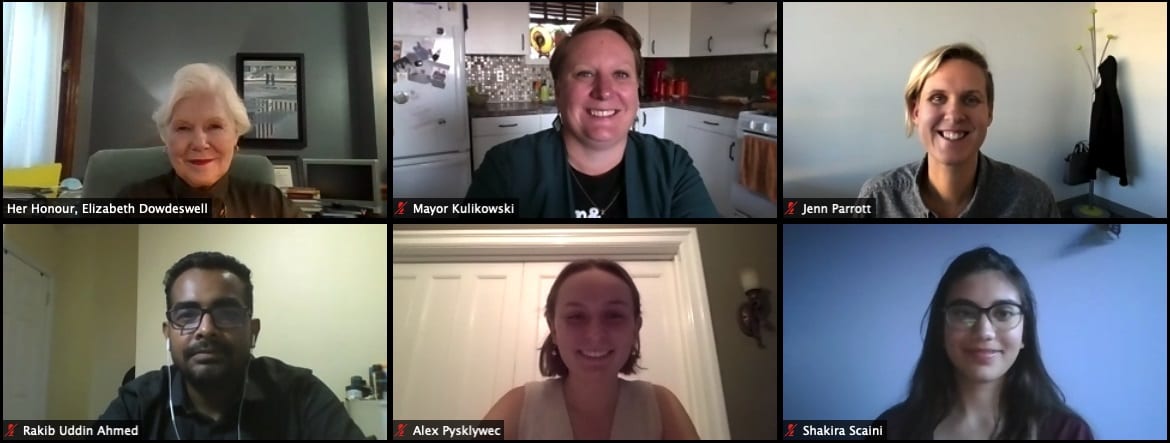It's no secret that the cost of living in Inuvik is extraordinarily high, largely attributed to its location, but also from the high costs of fuel in the area.

Photo courtesy Natasha Kulikowski
To this end, a transcontinental competition which just wrapped up connected engineering students from across Ontario to local authorities in Inuvik to discuss potential solutions. The winners of the competition, Alex Pysklywec, Shakira Scaini and Rakib Uddin Ahmed proposed installing a flywheel to store energy generated by Inuvik's energy grid.
Organized by the How to Change the World - Recovery project, the contest was one of several held across the western hemisphere to help students develop ideas and network them with industry professionals.

Photo courtesy How To Change the World
"We created the course to provide an experiential learning opportunity to work on real-world problems with stakeholders who deal with those problems day-in-day-out," said program founder Jason Blackstock. "At the beginning of 2020, we decided we have to do a program in Canada. We ran the inaugural in-person program in February, and then Covid-19 happened.
"That's when we decided to run a fully virtual program. So we set up a pilot."
A flywheel is effectively a mechanical battery that stores energy by moving. The idea, were it to be implemented, would be that excess power generated during low-demand portions of the day would be converted into kinetic energy in the fly wheel system. When energy demands spike, the flywheels can be slowed down and the energy they give off can be re-converted back to electricity.
As of 2017-18, Inuvik generated 39 per cent of its electricity from natural gas, 60 per cent from diesel generators and 1 per cent from solar panels. The natural gas generators need to run constantly, forcing ratepayers to cover the costs of running the generators during low-demand hours. On top of that, shifting the capacity of the generators from low to high demand greatly reduces the equipment's lifespan, which further increases energy costs. Currently excess energy generated during low-demand hours is lost, but a storage system such as a flywheel could hold onto that energy until it is needed.
Unlike conventional batteries, flywheels also do not have to convert electricity from alternating current to direct current and back, which also consumes energy.
"One of the groups reached out and had very specific questions about power," said Mayor Natasha Kulikowski, who was one of the judges for the competition. "So I was able to refer them to Mike Ocko at the Northwest Territories Power Corporation. Through their conversations with him they changed their project entirely, and that was the one that ended up winning.
"So the group that went as far as contacting someone here in Inuvik who was actually facing the issues was the one that came up with the best solution. Taking those extra steps on the research side lead them to have the strongest project.
"Looking at the flywheel and how it's presented, it looks like it would be feasible. So now it's a question on how we generate an idea to move this idea forward, or putting it in someone's wheelhouse to think about."
Now that the contest is over, the participants have largely moved on to other ideas, leaving their concept for more ambitious civic planners. However, a second project organized by How to Change the World that concluded proposes establishing an internship program through the Inuvialuit Regional Corporation to bring more engineers up north to begin working on new solutions.
The Northern Knowledge Connections project would, if implemented, connect students from southern Ontario with contacts in the IRC would have a goal of maintaining a 70 per cent retention rate of students brought into the area by the IRC. The interns would not only gain valuable work experience but also learn about Inuvialuit culture and spread greater awareness among Canadians down south.
"It's an awesome opportunity for engineering and business students to not only get technical experience, but also engaging with stakeholders," said team member and research associate Mackenzie Briand. "There was amazing portfolios looking at Inuvik. I'm looking to work with my group and actually implement ours. We've already identified some funding opportunities and we're looking to partner with Career Launcher.
"The opportunity to develop your solution is there and we're looking to help anyone who wants it."
How to Change the World is an capstone course established in 2014 at University College London, in the United Kingdom. Since it was started it's grown to over 900 students a year. It gives access to industry professionals and networking opportunities and has now become an international program.